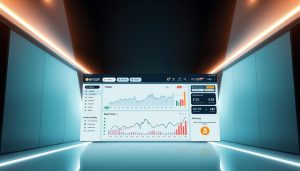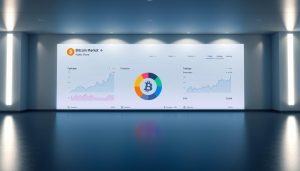Here’s a startling fact: 99.9% of individual miners never solve a single block. Today’s network difficulty levels make solo mining incredibly challenging. The odds are stacked against individual efforts.
The cryptocurrency mining landscape has changed dramatically. In the early days, you could mine coins on a laptop. Now, hash rates are measured in exahashes per second. These numbers are almost incomprehensible to most people.
Miners face a crucial decision: strategy. Should they go solo for a potential jackpot? Or join a pool for smaller, more frequent rewards? This choice can greatly impact their success.
Modern ASIC machines perform trillions of calculations per second. Yet, even with this power, solo mining remains a gamble. Understanding these changes is crucial for miners.
Key Takeaways
- Solo miners have less than 0.1% chance of successfully finding a block independently
- Pool participants receive smaller but more consistent payouts compared to solo efforts
- Network difficulty in 2025 requires specialized ASIC hardware for any profitable operation
- Hash rates now measure in exahashes, making CPU and GPU setups obsolete
- Your choice impacts both potential earnings and electricity cost efficiency
- Modern equipment costs can range from thousands to tens of thousands of dollars
Understanding Bitcoin Mining Basics
Bitcoin miners validate and secure the network behind the scenes. They’re crucial for every transaction you make. Let’s explore different cryptocurrency mining methods and understand what miners actually do.
Bitcoin mining is like digital auditing and security rolled into one. Miners aren’t just making easy money with computers. They form the backbone of Bitcoin’s security system.
What Is Bitcoin Mining?
Bitcoin mining involves solving complex puzzles to verify transactions and add blockchain blocks. Miners compete to solve these puzzles and prove transactions are legitimate.
The first to crack the puzzle adds the next block of transactions. They receive a reward of 3.125 BTC after the 2024 halving event.
The network uses automatic difficulty adjustment to maintain a 10-minute block time. This happens every 2,016 blocks, regardless of miner numbers.
How Bitcoin Transactions Are Processed
When you send Bitcoin, it waits in the mempool with other pending transactions. Miners select transactions, prioritizing those with higher fees.
They bundle these into a block and race to solve the puzzle. The winner broadcasts their solution for network verification.
Once confirmed, the new block joins the blockchain permanently. Your transaction is now complete and irreversible.
This process needs significant computational power and energy. That’s why different cryptocurrency mining methods have developed for efficiency and profit.
The system is decentralized, with no single controlling authority. It maintains security through math and economic incentives. Understanding this helps you choose the best mining approach.
The Process of Solo Bitcoin Mining
Solo mining in 2025 is far more complex than most people realize. It requires serious consideration and substantial resources. The landscape has evolved dramatically over the past decade.
Solo mining represents Bitcoin’s original vision – individual miners competing directly with the network. They use their own equipment and keep all rewards. You’re literally competing against industrial mining farms with thousands of machines.
Definition and Key Characteristics
Solo mining means mining alone. No pools, no shared resources, no splitting rewards. When you solve a block, you keep the entire 3.125 BTC reward plus fees.
Solo mining involves complete independence from mining pools. You’re fully responsible for your own mining operations. You maintain direct control over your mining software and hardware configurations.
Solo mining is essentially a lottery system. Your hash rate determines how many tickets you buy. Even with top-tier hardware, chances remain incredibly slim in today’s competitive environment.
“Solo mining is like buying lottery tickets – except the odds change every two weeks, and the tickets cost thousands of dollars in electricity.”
Equipment Needed for Solo Mining
Consumer-grade hardware won’t cut it anymore. You need industrial ASIC miners to have any realistic chance of success. The current gold standard includes machines like the Bitmain Antminer S19 Pro and WhatsMiner M50.
These machines aren’t cheap. Expect to pay anywhere from $3,000 to $8,000 per unit, depending on market conditions. But the miners are just the beginning.
You’ll also need robust electrical infrastructure, professional cooling systems, and a reliable internet connection. Backup power solutions, proper ventilation, and noise management systems are essential too.
- Robust electrical infrastructure capable of handling 3,000+ watts per miner
- Professional cooling systems to prevent overheating
- Reliable internet connection with minimal downtime
- Backup power solutions for consistent operation
- Proper ventilation and noise management systems
Electricity costs can be staggering. Most successful solo miners operate in regions where electricity costs less than $0.08 per kWh. Higher costs likely mean mining at a loss.
Potential Rewards and Risks
The reward structure in solo mining is straightforward but brutal. Find a block, and you receive the full reward. Miss a block, and you get nothing for your efforts.
With current network difficulty, a single Antminer S19 Pro has slim chances of finding a block. Statistically, you might wait 3-5 years between successful blocks. This makes choosing solo mining a critical decision.
The risks are substantial and multifaceted:
- Extended periods without any income while electricity costs continue
- Hardware depreciation and potential equipment failures
- Increasing network difficulty reducing your chances over time
- Market volatility affecting the value of potential rewards
However, the potential rewards can be life-changing. A single block reward at current Bitcoin prices represents a significant windfall. Some miners have struck it lucky, finding multiple blocks quickly.
Solo mining requires incredible patience and financial resilience. You need to be prepared for continuous expenses with no guaranteed return. It’s not for those with limited resources.
Success in solo mining now requires industrial-scale thinking. Substantial capital investment is necessary to compete in today’s environment. Understanding these factors is crucial for making informed decisions.
The Mechanics of Pool Bitcoin Mining
Pool mining turns solo Bitcoin mining into a team effort. Miners join forces, combining their computing power. This method has become popular among serious miners today.
Pool mining’s strength lies in its collective approach. Solo mining is like buying lottery tickets. With pool mining, you’re part of a group that wins more often.
Definition and Key Characteristics
A mining pool is a group of miners who work together. They combine their hash power to find blocks faster. The key characteristic that sets pool mining apart is proportional reward distribution.
Pool mining works on a simple idea. Many small efforts create one powerful mining force. Your mining rig connects to the pool’s servers for work assignments.
The pool tracks everyone’s efforts through shares. These shares prove you’re doing the required work.
How Mining Pools Function
Pool mining mechanics are surprisingly simple. You don’t mine complete blocks when connected to a pool. Instead, you work on smaller parts of the mining puzzle.
The pool server sends your equipment a template with transactions. Your hardware calculates and submits valid shares back to the pool. These shares prove you’re contributing computational power.
When the pool mines a block, it earns 3.125 BTC plus fees. This reward is shared based on each miner’s contribution. Popular pools like Slush Pool have refined this process over time.
Advantages of Pool Mining
The bitcoin mining pool advantages are clear for most miners. You get predictable income instead of waiting months for a solo block discovery.
Pool mining also reduces earnings fluctuations. Your income becomes more stable, helping with planning your mining operation. This consistency is crucial for miners who need steady income.
Understanding pool mining fees explained is key to maximizing profits. Most pools charge 1% to 3% of your earnings. Different payout methods can affect your bottom line.
| Pool Feature | Pay Per Share (PPS) | Pay Per Last N Shares (PPLNS) | Proportional |
|---|---|---|---|
| Fee Range | 2.5% – 4% | 1% – 2% | 1% – 2.5% |
| Payout Timing | Immediate | After block confirmation | After block confirmation |
| Risk Level | Low (pool takes risk) | Medium (shared risk) | Medium (shared risk) |
| Best For | Steady income seekers | Long-term miners | Occasional miners |
The trade-off is clear: consistent earnings instead of potential massive solo rewards. For most miners, especially beginners, this reduces risk while maintaining profitability.
Comparing Earnings: Solo vs. Pool Mining
Let’s focus on what really matters – your potential earnings. The solo vs pool mining debate impacts your wallet directly. It determines whether you’ll cover costs or watch your savings vanish.
I’ve tracked earnings from both methods for over two years. The results might surprise you. Especially if you’re hoping to hit that solo mining jackpot.
Reward Potential in Solo Mining
Solo mining is high-risk, high-reward in cryptocurrency. Finding a block means keeping the entire reward – 3.125 BTC plus fees. That’s about $130,000 at $42,000 per Bitcoin.
But reality hits hard. With a 100 TH/s ASIC miner, your daily block-finding chance is 0.0025%. That’s not a typo – you might find one block every 400 days.
Network difficulty increases make it worse. Some miners go 18 months without finding a block. They waste thousands on electricity costs.
Consistent Earnings in Pool Mining
Pool mining offers predictable daily payouts. A 100 TH/s setup earns about 0.008 BTC daily in a good pool. After fees, you’re looking at roughly $336 per day at current prices.
The key word here is consistent – you can budget around these earnings. Over a year, pool mining generates about 2.9 BTC. That’s more than solo mining’s theoretical 2.8 BTC.
Statistical Analysis of Profitability
The numbers reveal a compelling story in the bitcoin mining rewards comparison. I’ve gathered data from my operations and mining communities. Here’s the real picture:
| Mining Method | Daily Earnings (100 TH/s) | Annual Earnings | Variance Risk | Break-even Time |
|---|---|---|---|---|
| Solo Mining | $0 – $130,000 | 2.8 BTC (theoretical) | Extremely High | Unpredictable |
| Pool Mining | $320 – $350 | 2.9 BTC (actual) | Very Low | 8-12 months |
| Small Pool | $315 – $340 | 2.8 BTC (actual) | Low | 9-13 months |
| Large Pool | $325 – $355 | 3.0 BTC (actual) | Very Low | 7-11 months |
Variance is crucial. Solo mining is like a lottery ticket with terrible odds. Network difficulty has jumped 300% in two years. This makes individual mining less viable.
My models suggest this trend will speed up. As big miners join, solo mining becomes even harder. Block-finding chances shrink while electricity costs stay the same.
Pool fees are insurance against variance. You’re paying 1-3% for guaranteed income instead of gambling on slim odds. Miners who switched to pools saw stable income within a month.
Half of solo miners quit within six months due to money problems. The data shows pool mining is more sustainable for most.
Essential Tools for Bitcoin Miners
Your equipment choices define mining success. The right combo of hardware, software, and platforms can make or break profitability. Let’s explore what works in today’s competitive mining landscape.
Recommended Hardware for Solo Mining
Solo mining requires serious hardware investment. You can’t compete with industrial operations using just any ASIC miner.
The Bitmain Antminer S19 series is the gold standard for serious miners. These units deliver 90-110 TH/s with good power efficiency. The S19 Pro hits 110 TH/s while using about 3,250 watts.
WhatsMiner’s M50 series offers solid competition. Their M50S model reaches 126 TH/s, but runs hotter and uses more power than Bitmain units.
Here’s what most guides don’t tell you about hashrate requirements for solo mining: paper specs don’t guarantee success. You need consistent, reliable hash power to have a real shot at finding blocks.
You need at least 500 TH/s to even consider solo mining seriously, which means multiple ASIC units and a serious electrical setup.
This means running 4-5 high-end ASIC miners at once. You’ll need cooling, electrical infrastructure, and backup systems. Most successful solo miners operate warehouse-scale facilities.
| ASIC Model | Hash Rate (TH/s) | Power Consumption (W) | Efficiency (J/TH) |
|---|---|---|---|
| Antminer S19 Pro | 110 | 3,250 | 29.5 |
| WhatsMiner M50S | 126 | 3,276 | 26 |
| Antminer S19j Pro | 100 | 3,050 | 30.5 |
| WhatsMiner M30S++ | 112 | 3,472 | 31 |
Top Mining Pool Platforms
Pool mining offers more flexibility with hardware. Even a single ASIC can generate returns when contributing to collective efforts.
Slush Pool, the world’s first mining pool, maintains excellent transparency. They offer detailed stats and charge a reasonable 2% fee.
F2Pool dominates global hash rate distribution. They provide good geographic coverage and competitive 2.5% fees. Their interface needs work, but payouts are consistent.
AntPool works great with Bitmain hardware. Their optimizations can boost Antminer performance. Fees range from 1-3% depending on payout method.
Newer pools like Foundry USA and Binance Pool are gaining traction. Foundry focuses on North American miners. Binance leverages their exchange for added benefits.
Software Options for Both Mining Types
Mining software connects hardware to networks and manages operations. The wrong choice can cost you significant earnings.
CGMiner is the most versatile option for advanced users. It supports almost every ASIC model and offers extensive customization.
BFGMiner focuses on FPGA and ASIC mining. It has useful features like dynamic clocking and remote interfaces. It’s great for managing multiple units.
ASIC manufacturers often include their own software. Bitmain’s works well for basics but lacks advanced monitoring features.
For comprehensive monitoring, consider Awesome Miner or Hive OS. These manage multiple miners, track profitability, and send alerts.
Cloud mining services offer alternatives to hardware ownership. However, they rarely outperform direct hardware investment long-term.
Match your software to your operation’s scale and expertise. Start simple, then add complexity as you grow more comfortable.
Graphical Insights into Mining Trends
Charts and graphs show the tough realities of modern bitcoin mining. Visual data tells a story every miner needs to know before investing. These trends shape the whole cryptocurrency mining landscape today.
Mining data over the years reveals clear patterns. The numbers don’t lie about the industry’s direction. Understanding these trends helps miners make smarter choices about their operations.
Bitcoin Mining Difficulty Over Time
Bitcoin mining difficulty has grown exponentially since 2009. The curve looks almost vertical on long-term charts. Difficulty was once measured in millions, now it’s in tens of trillions.
The network adjusts difficulty every 2,016 blocks to keep 10-minute block times. More miners or better equipment cause difficulty to rise. This keeps the system stable but makes mining harder.
Hash rates hit all-time highs in 2025, pushing difficulty to new levels. This growth explains why building a bitcoin mining rig needs careful planning. Each adjustment makes older equipment less profitable or useless.
Earnings Comparison Graph: Solo vs. Pool
Solo and pool mining earnings graphs tell different stories. Pool mining shows a steady downward slope as difficulty increases. It’s consistent but slowly declining.
Solo mining charts look like earthquake readings. Long flat periods are broken by huge spikes when blocks are found. These swings make solo mining risky for most miners today.
Bitcoin mining payout structures differ between these approaches. Pools offer daily or hourly payouts after reaching minimums. Solo mining is all-or-nothing, with possible months between payouts.
Consistency is key for long-term success. Pool miners can predict monthly earnings fairly well. Solo miners face total uncertainty about their next payout.
| Mining Method | Average Payout Frequency | Earnings Predictability | Minimum Threshold | Fee Structure |
|---|---|---|---|---|
| Solo Mining | Highly Variable (0-365+ days) | Extremely Low | Full Block Reward | No Pool Fees |
| Pool Mining | Daily to Weekly | High | 0.001-0.01 BTC | 1-3% Pool Fee |
| Cloud Mining | Daily | Medium | Varies by Provider | 15-25% Total Fees |
| Mining Farms | Weekly to Monthly | High | Contract Dependent | 10-20% Management |
Future Predictions for Mining Profitability
Most experts think mining difficulty will keep rising as better ASIC hardware comes out. Big miners are growing with huge facilities and top-notch equipment. This trend makes it harder for individual solo miners.
Pool mining will stay viable but with smaller profits as competition grows. Bitcoin mining payout structures in pools might change to help smaller miners. Some pools are trying new ways to share rewards.
ASICs will likely dominate even more in coming years. The gap between home and industrial mining gear keeps widening. This tech race favors big operations over individual miners.
Energy costs will be crucial for mining profits. Miners with cheap, renewable energy will have an edge. Those paying high rates may lose money regardless of their method.
The next bitcoin halving will cut block rewards in half again. This will squeeze profits even more. Halvings usually cause big changes in mining economics. Miners must prepare for these predictable but important events.
Frequently Asked Questions About Bitcoin Mining
The mining industry evolves rapidly. What worked before might not apply today. Let’s explore the top three questions I often receive.
Is Solo Mining Still Viable Today?
Technically, yes – solo mining still works exactly as it always has. You can mine independently and potentially earn full block rewards.
However, solo mining has become a rich person’s game. Network difficulty has increased dramatically. We now compete against massive mining farms with thousands of ASICs.
Many solo miners go months without finding a block. The math is brutal – even with top-tier ASICs, your chances are slim.
How to Choose Between Solo and Pool Mining?
Pool mining offers predictable returns, while solo mining is high-risk with potential big rewards. Your choice depends on risk tolerance and available capital.
For less than 100 TH/s, pool mining is the practical option. It provides steady income to cover costs and generate returns.
Larger operations must consider electricity costs, equipment depreciation, and potential income gaps. Some operations fail due to extended periods without solo mining income.
What Are the Fees Involved in Mining Pools?
Most reputable mining pools charge between 1-3% of your earnings. However, fee structures can vary significantly between pools.
Consider payout thresholds, minimum balances, and transaction fees. Some pools advertise “zero fees” but make money through other methods.
Always calculate the total cost of participation, including fees and payout delays. Check these factors before joining a pool:
- Base fee percentage (typically 1-3%)
- Minimum payout threshold
- Payout frequency options
- Transaction fees for withdrawals
- Any hidden costs or requirements
Reliability is crucial. A slightly higher fee from a stable pool is better than frequent downtime.
Some pools offer additional services like merged mining. Consider these benefits when comparing your options.
Evidence and Sources Supporting Mining Choices
Real-world evidence from successful mining operations offers vital insights for newcomers. I’ve tracked actual mining results for years. The data reveals what works in today’s competitive landscape.
Solid evidence from multiple sources is crucial for informed decisions. Personal experiences, research studies, and expert analysis all contribute to understanding mining.
Case Studies on Successful Miners
The best examples come from miners who adapted over time. Early Bitcoin adopters who started with CPU mining provide fascinating case studies. Many moved to GPU mining, then embraced ASIC technology.
Miners who scaled up or joined pools often stayed profitable. Those who resisted changes were often priced out. One example involves miners who invested in warehouse space and industrial equipment.
Their success came from treating Bitcoin mining as a serious business. They focused on operational efficiency, electricity costs, and equipment maintenance.
Research Studies on Mining Efficiency
Blockchain analytics firms have produced extensive research on mining trends. Studies show that over 60% of Bitcoin’s hash rate comes from major mining pools. This reflects the economic realities of modern cryptocurrency mining.
Research proves that ASIC dominance has made CPU mining obsolete. Network hash rates keep reaching all-time highs, making solo mining tougher. Data shows clear patterns in mining profitability based on scale and equipment efficiency.
Studies highlight the importance of electricity costs in mining operations. Cheap, reliable power sources attract large-scale mining facilities. This supports the trend toward pool mining participation.
Expert Opinions on Future Trends
Industry veterans predict continued consolidation in Bitcoin mining. They suggest that large-scale operations and pool mining will dominate even more. Mining conferences often discuss the need for significant capital investment.
Experts recommend treating mining as a serious business or learning experience. Casual solo mining no longer makes economic sense for most people. Professional miners stress understanding both technical and financial aspects.
Future trends point to more efficient hardware replacing older equipment. Experts expect continued difficulty increases and the need for scale. These predictions align with market trends and technological developments in mining.
Conclusion: Making an Informed Decision
Bitcoin mining has evolved from a hobby to a capital-intensive industry. Success now depends on scale, efficiency, and cheap energy access. The choice between mining approaches shapes your entire mining future.
I’ve learned that this decision isn’t just technical. It’s a business choice that requires careful consideration and planning.
Key Takeaways on Solo and Pool Mining
Solo mining is viable for those with significant capital and risk tolerance. It requires industrial-grade equipment and cheap electricity. You’ll need a financial cushion to handle months without rewards.
Pool mining offers a more predictable path, especially for newcomers. Steady payouts help you understand mining economics without extreme volatility. However, profitability still requires careful calculation of costs.
Successful mining today requires treating it as a business venture. Proper planning, realistic expectations, and sufficient capital are essential. This applies to both solo and pool mining.
Future of Bitcoin Mining Strategies
Large-scale industrial operations will expand, using renewable energy and economies of scale. They’ll maintain competitive advantages through these methods.
Pool mining operations will offer better fee structures and reliable payouts. They’ll likely integrate advanced analytics and automated cryptocurrency switching.
Well-capitalized individual miners may find niche opportunities in solo mining. They’ll need substantial capital investment and deep technical knowledge to compete effectively.
For newcomers, I recommend starting with pool mining to learn the fundamentals. This will help you understand the economics and operational challenges of mining.
Casual mining is no longer viable. However, opportunities exist for those adapting to professional-grade competition. Success in modern Bitcoin mining requires careful planning, adequate funding, and realistic return expectations.
Further Resources and Guides
The mining landscape changes fast. Staying informed requires the right resources. Combining formal education with community wisdom creates a strong foundation for success.
Online Communities for Miners
Reddit’s r/BitcoinMining and r/gpumining offer real-world insights from active miners. BitcoinTalk forum is great for technical discussions about hardware optimization.
Local mining groups provide face-to-face networking opportunities. These can’t be replicated online.
Comprehensive Tutorials on Mining
Bitmain and MicroBT offer detailed specs for ASIC miners like the Antminer S19 series. YouTube channels show visual guides for hardware setup and pool configuration.
Current mining analysis helps understand which cryptocurrencies work best with different hardware types.
Recommended Reading on Bitcoin Economics
Andreas Antonopoulos’s “Mastering Bitcoin” covers essential technical foundations. The free Princeton Bitcoin textbook provides in-depth academic knowledge.
Bitcoin Magazine tracks regulatory changes and market developments. These directly impact mining profitability.
Building relationships in the mining community is as valuable as technical knowledge. Continuous learning and practical experience create the best path forward.










 Bitcoin
Bitcoin  Ethereum
Ethereum  Tether
Tether  XRP
XRP  USDC
USDC  Lido Staked Ether
Lido Staked Ether  TRON
TRON  Dogecoin
Dogecoin  Cardano
Cardano